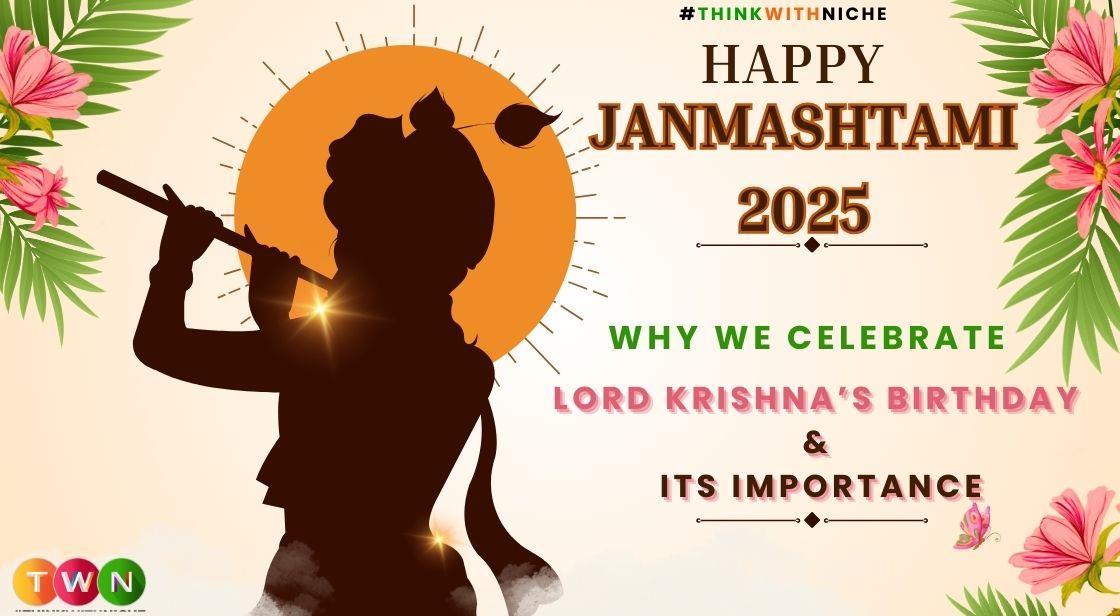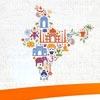Janmashtami 2025: Why We Celebrate Lord Krishna’s Birthday & Its Importance

Blog Post
Janmashtami, also known as Krishna Janmashtami, Krishnashtami, Gokulashtami, Ashtami Rohini, Srikrishna Jayanti, or Sree Jayanthi, is celebrated with immense joy and fervor by millions of devotees worldwide.
The festival marks the divine birth of Lord Krishna, believed to be the eighth and most beloved incarnation of Lord Vishnu. Celebrated on the eighth day (Ashtami Tithi) of the dark fortnight (Krishna Paksha) in the Hindu month of Bhadrapada, this day is a profound reminder of the triumph of good over evil.
The festival’s essence lies in its commemoration of divine love and the promise of a savior, with devotees observing fasts, wearing traditional attire, and adorning Lord Krishna's idols to seek blessings for the well-being and prosperity of their families.
The celebration is not merely a ritual but a heartfelt expression of devotion that unites communities in a spirit of faith and joy.
Lord Krishna Janmashtami 2025: Birth Story, Puja Timings & Celebration Guide
The Sacred Story of Sri Krishna’s Birth
In Indian culture, the name Krishna is synonymous with Prema (divine love) and Bhakti (unwavering devotion). The sacred story of his birth is an ode to his Avataran (incarnation) to restore dharma (righteousness) and protect Bhudevi (goddess Earth) from the tyranny of evil.
As narrated in the Dasham Skandha of the Srimad Bhagavatam, the divine birth took place in the prison cell of the wicked King Kamsa, where Devaki and Vasudeva were held captive. At midnight, Lord Vishnu appeared before them, announcing his descent as their eighth child.
The divine child was then miraculously transported to Gokula to the home of his foster parents, Maa Yashoda and Nandababa, who raised him as their own. The festival of Janmashtami commemorates this enchanting saga, celebrating the joy felt in both the mortal and celestial realms at his arrival and symbolizing the promise of divine love manifest on Earth.
Janmashtami 2025: Date and Dual Celebrations
According to the Hindu calendar, the Ashtami Tithi of the Krishna Paksha in the month of Bhadrapada is the auspicious time for Janmashtami. In 2025, the Ashtami Tithi begins on August 15 at 11:49 pm and ends on August 16 at 9:34 pm. As a result, the festival will be celebrated on two consecutive days, with different traditions following specific rituals:
-
August 15: Smarta Sampradaya: This date will be observed by the Smarta Sampradaya, which includes householders who worship the Panchdev (five principal deities). Their celebration is based on the presence of the Rohini Nakshatra at midnight, the exact time of Lord Krishna's birth.
-
August 16: Vaishnav Sampradaya: The Vaishnav Sampradaya, primarily followers of Lord Vishnu, will observe the festival on this day. Their tradition is based on the Udaya Tithi, which is the day's timing at sunrise.
Also Read: India Marks 79th Independence Day 2025 with Pride and Patriotism
Janmashtami 2025: Puja Timings
For devotees, the timing of the puja is of utmost importance, especially the midnight rituals that mark Lord Krishna’s birth. The Nishita Puja is the most significant, and its timings are as follows:
-
Nishita Puja Time: From 12:04 am to 12:47 am on the night of August 16. This 43-minute window is considered the most auspicious time for worship.
-
Brahma Muhurta: From 04:24 am to 05:07 am
-
Vijay Muhurat: From 02:37 pm to 03:30 pm
-
Twilight Time: From 07:00 pm to 07:22 pm
Janmashtami Celebrations, Rituals, and Interesting Facts
Janmashtami celebrations are a vibrant display of devotion and community spirit. Devotees perform a variety of rituals, including:
-
Fasting: Many devotees observe a full-day fast for 24 hours, which they break only after the Ashtami Tithi ends with the bhog (sacred food offering) prepared for Lord Krishna.
-
Adornment and Puja: Devotees bathe and dress the idols of Lord Krishna in new clothes and jewelry. This is followed by Nishita Puja at midnight, where offerings of Krishna's favorite foods like maakhan (white butter), milk, and curd are made.
-
Cultural Festivities: The festival is also celebrated with kirtan and joyful chanting of Lord Krishna's name. In several states, particularly Maharashtra, the tradition of Dahi Handi is a key highlight. In this event, young men form a human pyramid to reach and smash an earthen pot filled with butter and curd, symbolizing Krishna's playful childhood antics.
Seeing the Modern Spirit: ISKCON’s Role Today
Founded on July 13, 1966, in New York City by A. C. Bhaktivedanta Swami Prabhupada, ISKCON (International Society for Krishna Consciousness) has grown into a worldwide devotional movement rooted in the Gaudiya Vaishnava tradition.
Headquartered in Mayapur, West Bengal, ISKCON has over 800 temples and centers globally. Its mission revolves around devotional practices (bhakti-yoga), vegetarianism, global food relief, and spreading Krishna's teachings via the Bhagavad Gita and associated scriptures.
Temples across the world, including in Patna, are preparing epic celebrations for Janmashtami—featuring elaborate midnight abhishekam, thousands of dishes as prasad, and international participation.
Janmashtami Global Celebrations and Symbolism
Janmashtami is celebrated far beyond India’s borders. It’s observed with grandeur in countries like Singapore, New Zealand, UK, US, Canada, and is even a national holiday in Bangladesh.
In households, symbolic acts—such as bringing a flute (Krishna's iconic instrument) home on Janmashtami—are believed to bring divine blessings, peace, and fulfilled wishes.
Janmashtami in Bhadrapada: A Month of Spiritual Growth
The month of Bhadrapada, especially Krishna Paksha’s Ashtami, holds special spiritual significance. Paired with Ganesh Chaturthi, it underscores themes of dharmic action, devotion, balance, and progress in life’s journey.
Famous temples of lord krishna in india
India is home to countless temples dedicated to Lord Krishna, with some of the most famous and historically significant ones located in the sacred cities of Mathura and Vrindavan, where he is said to have been born and spent his childhood. Other prominent temples are spread across the country, each with its own unique history and architectural style.
Lord krishna Temples in Uttar Pradesh
Banke Bihari Temple, Vrindavan:
This is one of the most revered temples in Vrindavan. The name "Banke Bihari" refers to Krishna's posture, which is bent in three places (Tribhanga). The temple is known for its lively and vibrant atmosphere, especially during festivals like Holi and Janmashtami. A unique feature is the repeated drawing and opening of the curtains during the darshan (viewing) to prevent devotees from being overwhelmed by the deity's beauty.
Shri Krishna Janmabhoomi Temple, Mathura:
This temple complex is a deeply significant pilgrimage site as it is believed to be the exact birthplace of Lord Krishna. The main shrine, known as the Garbha Griha, marks the prison cell where he was born to Devaki and Vasudeva. The temple has been rebuilt multiple times throughout history and is a major center for Janmashtami celebrations.
Prem Mandir, Vrindavan:
A relatively modern temple, Prem Mandir is a magnificent architectural marvel built with white Italian marble. The temple complex spans 54 acres and is famous for its intricate carvings and musical fountains that depict the various pastimes of Radha and Krishna. It's a key spiritual and educational site that attracts visitors from all over the world.
Lord krishna Temples in Gujarat and Odisha
Dwarkadhish Temple, Dwarka:
Located on the western coast of Gujarat, this temple is one of the four main pilgrimage sites in the Hindu Char Dham circuit. It is dedicated to Krishna, who is worshipped here as the "King of Dwarka" (Dwarkadhish). According to legend, the original temple was built by Krishna's great-grandson, Vajranabha, over 2,500 years ago. The five-story structure, supported by 72 pillars, is a magnificent example of Chalukya architecture.
Jagannath Temple, Puri:
This temple in Odisha is a monumental structure dedicated to Lord Jagannath, a form of Lord Krishna, along with his siblings Balabhadra (Balarama) and Subhadra. The temple is famous for its towering spire and, most notably, the annual Rath Yatra, or Chariot Festival, which draws millions of devotees from across the globe.
Lord krishna Temples in Southern India
Udupi Sri Krishna Matha, Udupi:
Located in Karnataka, this temple was founded in the 13th century by the saint Madhvacharya. A unique feature of this temple is that devotees can only view the deity through a special, nine-holed window known as the Navagraha Kindi. The temple is also renowned for its "Paryaya" festival, where the management of the temple is ceremoniously handed over to one of the eight surrounding Mathas every two years.
Guruvayur Sri Krishna Temple, Guruvayur:
Often referred to as the "Dwarka of the South," this temple is one of the most important places of worship in Kerala. The deity is a four-armed form of Lord Vishnu, worshipped as Krishna, and is believed to have been brought to Earth by Guru, the preceptor of the gods, and Vayu, the god of winds.
Conclusion
Lord Krishna’s divine presence is deeply woven into the spiritual fabric of India, and his temples are not just places of worship but living symbols of devotion, art, and cultural heritage. From the serene banks of the Yamuna in Mathura to the sacred shores of Dwarka, each temple narrates unique tales of his life, teachings, and miracles.
Visiting these holy sites during Janmashtami or on any day of the year offers devotees a chance to experience peace, faith, and a deeper connection with the Supreme. Whether you are a spiritual seeker, a history enthusiast, or a lover of art and architecture, Lord Krishna’s temples are timeless treasures that continue to inspire millions across the world.
You May Like
EDITOR’S CHOICE












